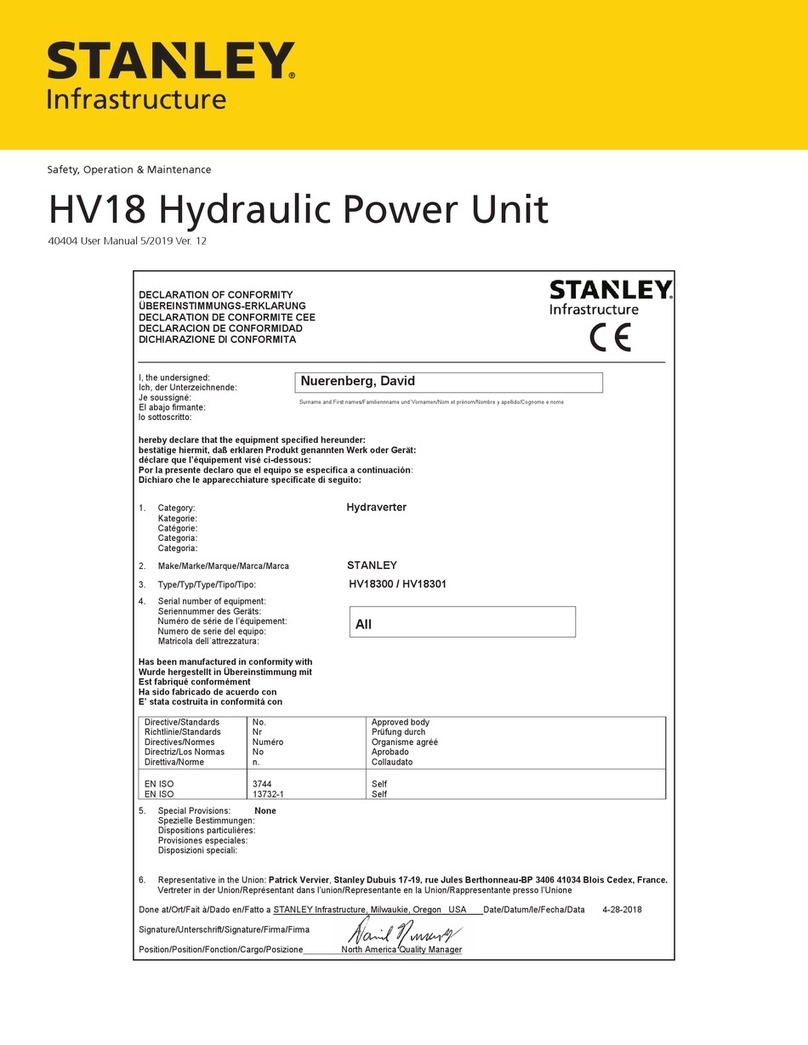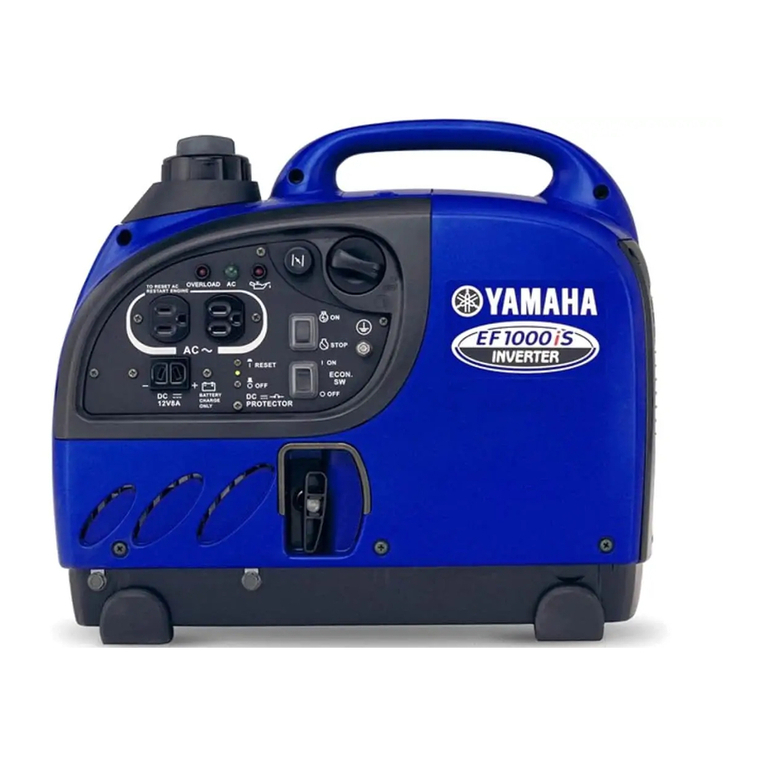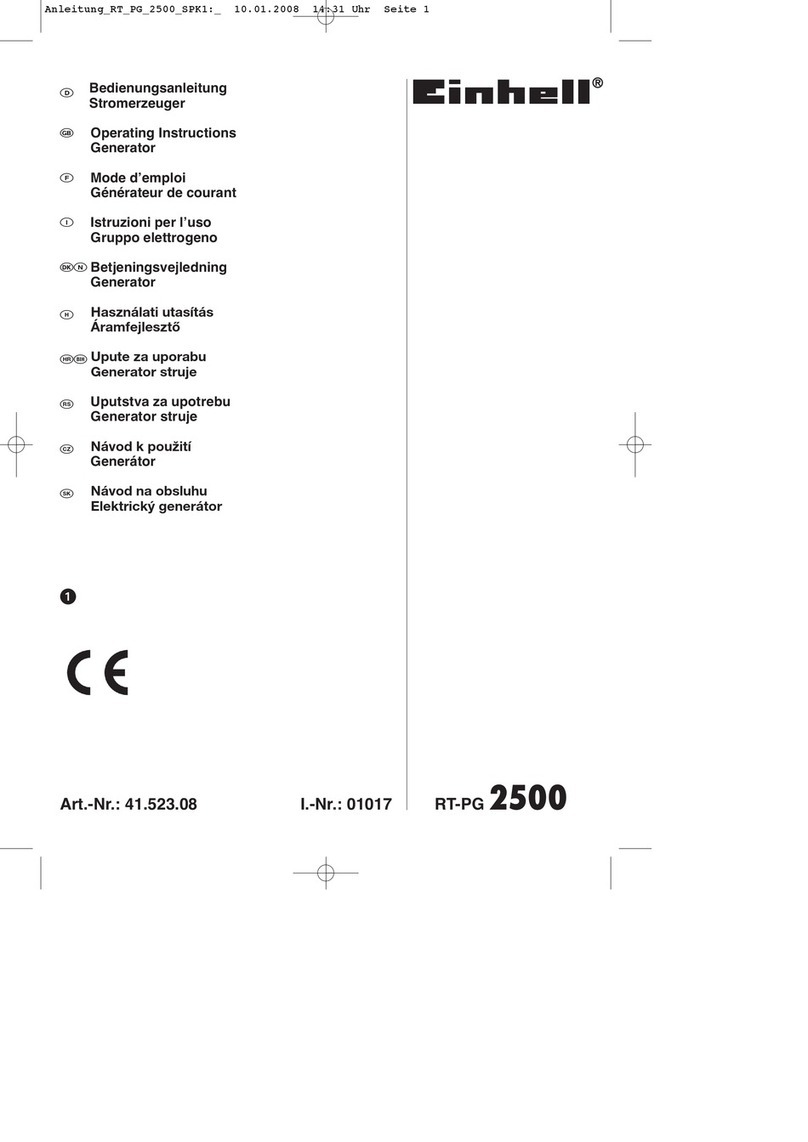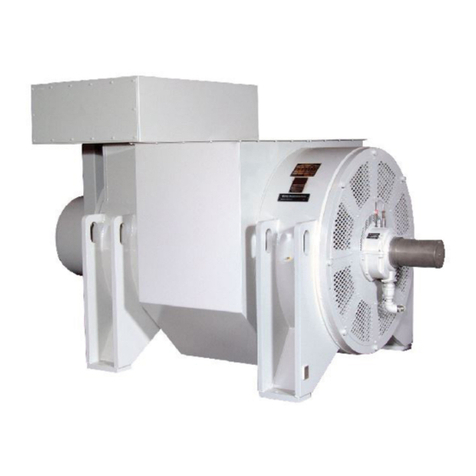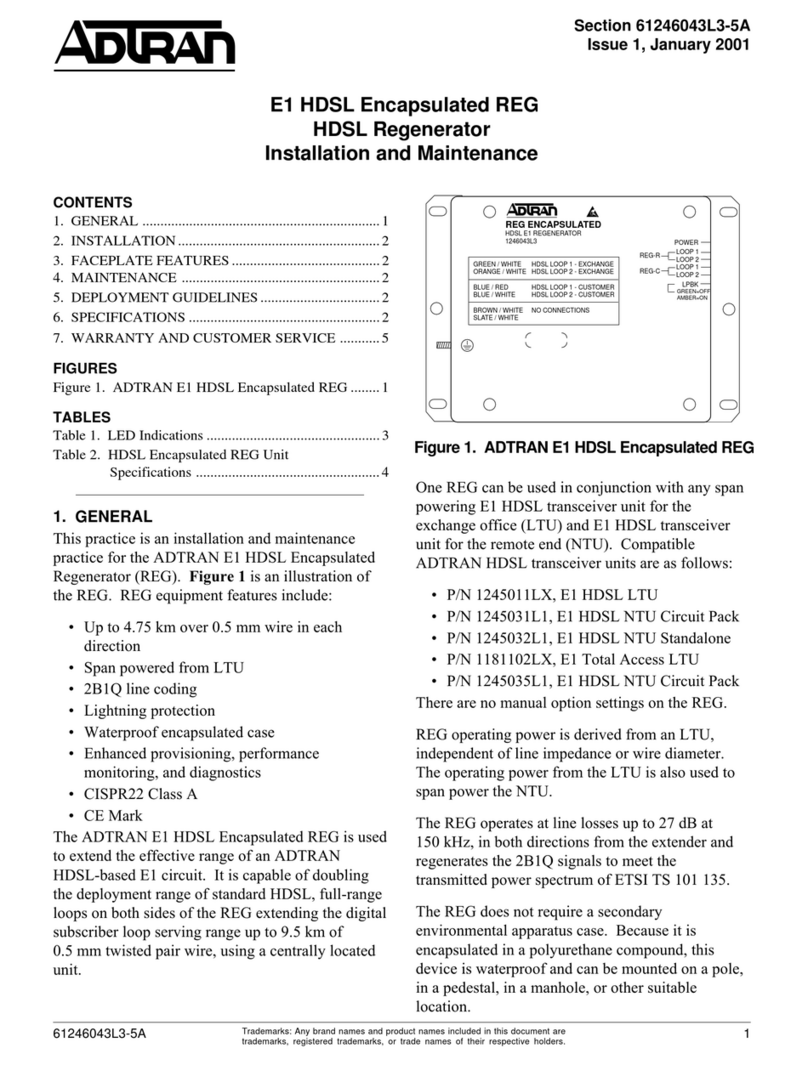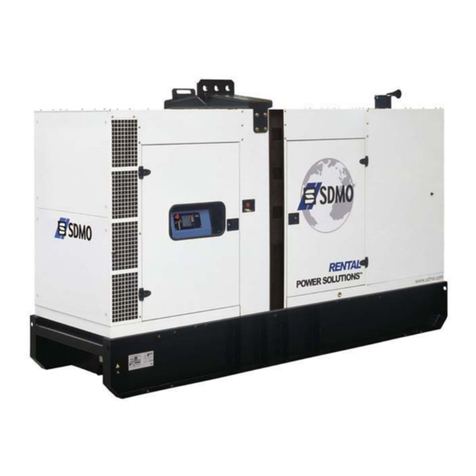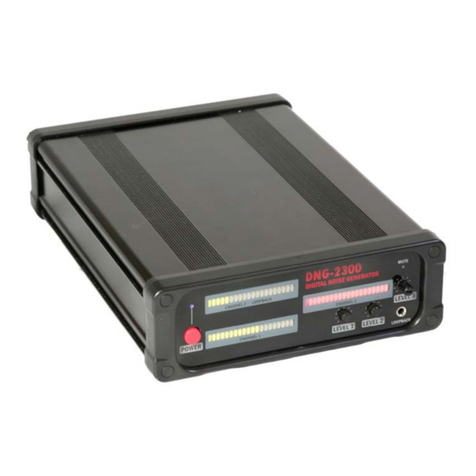Boonton SGX1000 Series Owner's manual

PMX40 RF Power Meter –INSTRUCTION MANUAL
PROGRAMMING REFERENCE
SGX1000
RF Signal Generator
98409600A | Rev 20220517


SGX1000 Series RF Signal Generator –PROGRAMMING REFERENCE
Revision 220517
© Copyright 2022, by BOONTON Electronics, a subsidiary of the Wireless Telecom Group, Inc.
25 Eastmans Road, Parsippany, NJ 07054, USA. All rights reserved.
P/N 98409600A
This manual covers the SGX1000 Series RF Signal Generators, serial numbers: 17976 and higher.
The SGX1000 application software used in this product is licensed by Boonton Electronics, a subsidiary of
the Wireless Telecom Group, Inc.

SAFETY SUMMARY
The following general safety precautions must be observed during all phases of operation and
maintenance of this instrument. Failure to comply with these precautions or with specific warnings
elsewhere in this manual violates safety standards of design, manufacture, and intended use of the
instrument. Boonton Electronics assumes no liability for the customer’s failure to comply with these
requirements.
DO NOT OPERATE THE INSTRUMENT IN AN EXPLOSIVE ATMOSPHERE
Do not operate the instrument in the presence of flammable gases or fumes.
DO NOT OPERATE THE INSTRUMENT OUTSIDE
This instrument is designed for indoor use only.
KEEP AWAY FROM LIVE CIRCUITS
Operating personnel must not remove instrument covers. Component replacement and internal
adjustments must be made by qualified maintenance personnel. Do not replace components with the
power cable connected. Under certain conditions dangerous voltages may exist even though the power
cable was removed, therefore; always disconnect power and discharge circuits before touching them.
DO NOT SERVICE OR ADJUST ALONE
Service and adjustments should be performed only by qualified service personnel. Do not attempt
internal service or adjustment unless another person, capable of rendering first aid and resuscitation, is
present.
DO NOT POSITION THE INSTRUMENT SO THAT IT IS DIFFICULT TO OPERATE THE DISCONNECTION
DEVICE
The main power disconnection switch is located on the rear panel.
DO NOT SUBSTITUTE PARTS OR MODIFY INSTRUMENT
Do not install substitute parts or perform any unauthorized modifications on the instrument. Return the
instrument to Boonton Electronics for repair to ensure that the safety features are maintained.

SGX1000 Series RF Signal Generator –PROGRAMMING REFERENCE
SAFETY SYMBOLS
This safety requirement symbol has been adopted by the International Electro-technical
Commission, Document 66 (Central Office) 3, Paragraph 5.3, which directs that an
instrument be so labeled if, for the correct use of the instrument, it is necessary to refer
to the instruction manual. In this case it is recommended that reference be made to the
instruction manual when connecting the instrument to the signal source and USB host.
The CAUTION symbol denotes a hazard. It calls attention to an operational procedure,
practice or instruction that, if not followed, could result in damage to or destruction of
part or all of the instrument and accessories. Do not proceed beyond a CAUTION
symbol until its conditions are fully understood and met.
The NOTE symbol is used to mark information which should be read. This information
can be very useful to the operator in dealing with the subjects covered in this section.
The HINT symbol is used to identify additional comments which are outside of the
normal format of the manual and provide users additional information about the
subject.


Contents
1 Remote Operation..................................................................................................................................1
1.1 LAN Configuration...............................................................................................................1
1.2 GPIB Configuration..............................................................................................................1
1.3 SCPI Language.....................................................................................................................1
1.3.1 SCPI Structure ................................................................................................2
1.3.2 Long and Short Form Keywords.....................................................................2
1.3.3 Colon Keyword Separators ............................................................................2
1.3.4 Command Arguments and Queries ...............................................................3
1.3.5 Semicolon Command Separators...................................................................3
1.3.6 Command Terminators..................................................................................3
1.3.7 SGX1000 SCPI Implementation......................................................................4
1.3.8 Sending Out of Range Values.........................................................................4
1.4 Basic Operation Information...............................................................................................5
1.5 SCPI Command Reference ..................................................................................................5
1.5.1 IEEE 488.2 Commands ...................................................................................5
1.5.2 DISPlay Subsystem.........................................................................................6
1.5.3 OUTput Subsystem ........................................................................................6
1.5.4 SOURce Subsystem ........................................................................................6
1.5.5 SYSTem Subsystem ........................................................................................9
1.5.6 SCPI Command Summary ............................................................................10


1
1Remote Operation
1.1 LAN Configuration
The SGX1000 LAN interface is configured using the System > I/O Config > LAN menu. The instrument
may be set to automatically accept its IP address and associated information from a DHCP server, or
the configuration data may be entered manually.
The SGX1000 communicates via the VXI-11 protocol for LAN control, which is a TCP/IP based format
that allows GPIB operation to be emulated via the LAN. Once the LAN parameters have been
configured, the controller can perform a broadcast and find all instruments on the subnet, or the
instrument’s IP address (whether manually or automatically assigned) may be used to assist the
remote control software in locating and connecting to the SGX1000. Typically, the host will use VISA
to provide the interface layer between the instrument and the remote-control software.
Caution
The supplied Ethernet cable fitted with a ferrite core must be used for RF interference
suppression. The end with the ferrite core should be connected to the SGX.
1.2 GPIB Configuration
GPIB remote control is enabled with option SGX-GPIB.
The SGX1000 GPIB interface is configured using the System > I/O Config > GPIB menu. The primary
listen/talk address (MLTA) can be set to any value from 1 to 30 inclusive. The value assigned must be
unique to each GPIB device. Secondary address is not implemented.
ASCII talk and listen terminators are not required or supported –the SGX1000 supports the industry
standard EOI method of terminating strings send to and from the instrument. The talking device must
assert the EOI bus signal on the GPIB bus when transmitting the final character of the message. This
function is performed automatically by most GPIB controllers. If a CR and/or LF is present at the end of
an incoming GPIB message, it will simply be ignored by the SGX1000.
1.3 SCPI Language
SGX1000 instruments may be remotely controlled using commands that follow the industry-standard
SCPI programming conventions. The default language is:
SYSTem:LANGuage SCPI
All the functions of the SGX1000 are accessible remotely via SCPI commands.

2
1.3.1 SCPI Structure
The SCPI instrument model defines a hierarchical command structure based on “command nodes”. Each
node may contain commands or names of a next-level command node. Each command is formed of a
series of keywords joined together and delimited by a colon “:”character. The command begins with a
colon at the “root node”, and traverses downwards through the command tree to form a specific
command. This structure is very similar to a DOS file system, where the file system begins at the root
level (“:”), and each directory (SCPI subsystem) may contain a list of files (SCPI commands) and lower-
level directories. To execute an individual command, the entire command name (―path) must
generally be specified, although there are several shortcuts available to reduce the command string
length.
SCPI subsystems or command groups are usually aligned with instrument functions, and the standard
provides a number of pre-defined subsystems that can be used for most instrument types. For example,
the top-level SOURce subsystem groups commands that are related to source signals (frequency,
amplitude, sweep point count…), while the OUTPut subsystem contains commands that control output
functions of the instrument (RF ON or OFF).
1.3.2 Long and Short Form Keywords
Each command or subsystem may be represented by either its full keyword, or a short form of that
keyword. The short form is typically the first several characters of the full name, although this is not
necessarily the case. The short form of each keyword is identified in this manual by the keyword
characters shown in UPPERCASE, while the long form will be shown in mixed case. For example, the
short form of “SOURce”is “SOUR”, while the long form is “SOURce”. Long form and short form
commands may be used interchangeably, but only the exact forms are permitted –intermediate length
commands will not be recognized. Sending “SOURc”will cause an error.
Note that not all keywords have long forms –in this case, the entire keyword will be shown in
uppercase.
While uppercase and lowercase text is used to identify keywords, SCPI is generally case-insensitive, so it
is acceptable to send uppercase, lowercase, or mixed case keywords to the instrument. The only
exception is when a command accepts a literal string argument. In this case, quotes may be used to
delimit a string of user-defined case.
1.3.3 Colon Keyword Separators
The colon (“:”) character is used similar to the way a slash or backslash is used in a filesystem. Prefixing
a command string with a colon resets parsing at the root command level, and a colon must separate
each keyword in the command. Beginning a new line always resets parsing to the root level, so the
leading colon is optional if the command is the first command on a line.

3
1.3.4 Command Arguments and Queries
Many commands require arguments. In this case, the entire command string is sent, followed by the
argument. A space is used to separate the command from the argument. For example,
“SOURce:FREQuency 1e9”sets frequency to 1 GHz. Arguments may be numeric, or alphanumeric. If a
command requires more than one numeric argument, the arguments must be sent as a comma
delimited list.
To read the current value of a particular parameter, the Query Form of its command may be used. A
command query is formed by appending a question-mark (“?”) suffix to the command instead of an
argument list. There should not be any whitespace between the command and the suffix. For example,
“SOURce:FREQuency?”queries the frequency parameter and causes the instrument to return its
current value.
1.3.5 Semicolon Command Separators
The semicolon (“;”) character is used to separate multiple commands on a single line. However, the
parsing path is affected when more than one command is combined on a line. As noted previously, the
first command of a line is always referenced to the root level whether, or not, the command is prefixed
by a colon. However, for the second and succeeding commands, the parsing level is NOT reset to the
root level, but rather referenced from the current node. This allows the parser to remain at the current
node and execute other commands from that node without resending the entire node string. For
example, the following multi-command strings are equivalent:
:SOURce:FREQuency 1e9; :SOURce:POWer 2.12; (two full-path commands)
:SOURce:FREQuency 1e9; :POWer 2.12; ( second command referenced to SOURce node)
SOURce:FREQuency 1e9; :POWer 2.12; (leading colon omitted from first command)
If a command does not belong to the same subsystem as the preceding command on the same line, then
its full path must be specified, including the colon prefix.
1.3.6 Command Terminators
All SCPI command strings transmitted to the instrument must be terminated. For commands sent via the
GPIB bus, any character with the IEEE488 EOI (End-Or-Identify) control line asserted may be used as a
terminator. This may be the last letter of the command, query, or argument. Optionally, a CR (ASCII 13)
and/or LF (ASCII 10) may be included. These are ignored by the parser, but if present, the EOI must be
asserted on the last message character transmitted.
On USB and LAN messages, the packetized protocols provide automatic termination of each message.
Again, CR and/or LF may be present, but must be the last message character(s) of the packet.
When the terminating condition is met (end of GPIB message or end of USB or LAN packet), the SCPI
path is first reset to the root level, and the received message is then passed to the SCPI parser for
evaluation.

4
1.3.7 SGX1000 SCPI Implementation
The SCPI implementation for the SGX1000 provides a SOURce sub-system to handle parameter settings.
An OUTput sub-system provides control of the signal output state. DISPlay commands are used for
screen brightness. The SYSTem sub-system is used to change remote communications settings and turn
on/off the audible beep for button presses.
Examples:
:SOURce:POWer 1.0 Set the output amplitude to 1.0 dbm
:OUTput:STATe ON Turn on the RF output
:SOURce:POWer? Query the output amplitude setting
:OUTput:STATe? Query the state of the RF output
In the discussion and tables below, the following notation will be used:
Command name long and short form: SOURce
Optional command name in brackets: [SOURce]:FREQuency
Short Form: SOUR:FREQ
Command which takes numeric argument: SOURce:FREQuency <numeric_value>
Same command; query: SOURce:FREQuency?
Command with literal text argument: SOURce:SWEep:TRIGger:SOURce <character data>
Command with no query form: *RST
Command with query form only: SYSTem:COMMunicate:LAN:CONNection:STATe?
SYNTAX NOTES
Square brackets [ ] are used to enclose the list of valid arguments for a command, or a list of command
options separated by the vertical separator bar | character. This character is for syntax only and is not to
be entered as part of the command.
A literal argument denoted by <character data> indicates a word or series of characters, which must
exactly match one of the choices for the command. An argument denoted by <numeric_value> requires a
string which, when converted to a number, is within the range of valid arguments. Numerical values can
generally be in any common form including decimal and scientific notation. <Boolean> indicates an
argument which must be either true or false. Boolean arguments are represented by the values 0 or OFF
for false, and 1 or ON for true. Queries of Boolean parameters always return 0 or 1.
Curly braces {} are used to enclose two or more possible choices for a mandatory entry, separated by the
comma character. One of the enclosed options MUST be inserted into the command, and the braces are
not to be entered as part of the command.
1.3.8 Sending Out of Range Values
If out of range values are sent to the SGX in SCPI commands, the instrument will be set to the maximum
or minimum permitted value. For example, if the SGX is commanded to be set to a sweep point count of

5
>65,532, it will be set to 65,532. Alternatively, if the SGX is commanded to be set to a sweep point count
of 0 or 1, it will be set to 2. Some parameter limits, such as frequency are model dependent.
1.4 Basic Operation Information
The easiest way to generate a signal is by use of the OUTput:STATe command. Setting this to 1 or ON
turns on the output of the device at the currently displayed settings.
For finer control over the output parameters, individual configuration and function commands should
be used.
1.5 SCPI Command Reference
This section contains a list of all SCPI remote commands accepted by the SGX1000. The list is grouped by
SCPI subsystem or IEEE488.2 function and includes a detailed description of each command.
1.5.1 IEEE 488.2 Commands
The purpose of IEEE488.2 commands is to provide management and data communication instructions
for the system by
defining
a
set
of
“*xxx”
commands
(an
asterisk
followed
by
a
three
-character
code).
These
commands
allow
device
control
and
status monitoring and are the basis for some of the
commands of the SCPI STATus subsystem (see Section 5.5.17).
*IDN?
Description: Return the instrument identification string. This string contains the manufacturer, model
number, serial number, and firmware version number.
Syntax: *IDN?
Returns: < Mfgr, Model#, Serial#, Version# >
Valid Modes: Any
*RST
Description: Set the instrument to a known default configuration. Set measurements to STOP. Set
the sensor temperature offset flag to FALSE, set the SCPI file over-write permission to
FALSE, turn the internal Calibrator output OFF and clear the error queues. System
communication parameters are not changed. Instrument measurement functions are
set their default values (Table 3-4, Initialized Parameters in the SGX1000 Instruction
Manual).
Syntax: *RST
Argument: None
Valid Modes: Any

6
1.5.2 DISPlay Subsystem
DISPlay:BACKlight:BRIGhtness
Description: Set or return the backlight brightness for the LCD display in percent. Zero percent turns
the backlight off.
Syntax: DISPlay:BACKlight:BRIGhtness <numeric_value>
Argument: <numeric_value> = 0 to 100
Valid Modes: Any
1.5.3 OUTput Subsystem
The OUTput group of the command subsystem is used to toggle the output of the SGX1000.
[OUTput:]STATe
Description: Sets or returns the state of the RF Output.
Syntax: [OUTput:]STATe <Boolean>
Argument: <Boolean> = {0, 1, OFF, ON}, accepts all, returns 0, 1
Valid Modes: Any
1.5.4 SOURce Subsystem
The SOURce group of the command subsystem is used to configure parameters and change modes.
[SOURce:]FREQuency
Description: Set or return the CW frequency to generate. This is the frequency of the CW RF signal
generated when used in the CW operating mode.
Syntax: [SOURce:]FREQuency <numeric_value>
Argument: <numeric_value> = 4.9e+6 to 20.48e+9 Hz. limits are model dependent.
Valid Modes: Any
[SOURce:]FREQuency:MAXimum?
Description: Returns the maximum limit of the CW frequency setting that can be used with the
[SOURce:]FREQuency command for the SGX1000 model in use.
Syntax: [SOURce:]FREQuency:MAXimum?
Returns: <numeric value>
Valid Modes: Any
[SOURce:]FREQuency:MINimum?
Description: Returns the minimum limit of the CW frequency setting that can be used with the
[SOURce:]FREQuency command for the SGX1000 model in use.
Syntax: [SOURce:]FREQuency:MINimum?
Returns: <numeric value>
Valid Modes: Any

7
[SOURce:]POWer
Description: Set or return the RF power level for the output when [OUTput]:STATe is ON.
Syntax: [SOURce:]POWer <numeric_value>
Argument: <numeric_value> = -50.00 to +20.00 dBm. Limits are model dependent.
Valid Modes: Any
[SOURce:]POWer:MAXimum?
Description: Returns the maximum limit of the Amplitude setting that can be used with the
[SOURce:]POWer command for the SGX1000 model in use.
Syntax: [SOURce:]POWer:MAXimum?
Returns: <numeric value>
Valid Modes: Any
[SOURce:]POWer:MINimum?
Description: Returns the minimum limit of the Amplitude setting that can be used with the
[SOURce:]POWer command for the SGX1000 model in use.
Syntax: [SOURce:]POWer:MINimum?
Returns: <numeric value>
Valid Modes: Any
[SOURce:]ROSCillator:EXTernal:FREQuency
Description: Set or return the external reference frequency. This is the frequency of the external
reference signal when [SOURce:]ROSCillator:SOURce is set to EXTernal.
Syntax: [SOURce:]ROSCillator:EXTernal:FREQuency <character data>
Argument: <character data> = {10MHz, 100MHz}.
Valid Modes: Any
Restrictions: Internal reference is 100MHz only.
[SOURce:]ROSCillator:SOURce
Description: Set or return the reference source. This is used to choose between the external and
internal reference source.
Syntax: [SOURce:]ROSCillator:SOURce<character data>
Argument: <character data> = { INTernal, EXTernal }.
Valid Modes: Any
[SOURce:]MODulation:MODe
Description: Set or return the operation mode. This is used to select the CW mode or the Sweep
mode.
Syntax: [SOURce:]MODulation:MODe <character data>
Argument: <character data> = {OFF, SWEEP}. OFF sets the unit to CW mode.
Valid Modes: Any

8
[SOURce:]FREQuency:STARt
Description: Set or return the sweep start frequency to generate. This is the starting point of a
frequency sweep when the SGX1000 is operated in the Sweep mode.
Syntax: [SOURce:]FREQuency:STARt <numeric_value>
Argument: <numeric_value> = 4.9e+6 to 20.48e+9 Hz. Limits are model dependent.
Valid Modes: Any
[SOURce:]FREQuency:STOP
Description: Set or return the sweep stop frequency to generate. This is the ending point of a
frequency sweep when the SGX1000 is operated in the Sweep mode. If
[SOURce:]SWEep:TRIGger:SOURce is set to Free Run, the sweep will loop continuously while the
Sweep/Run slider is set to Run.
Syntax: [SOURce:]FREQuency:STOP <numeric_value>
Argument: <numeric_value> = 4.9e+6 to 20.48e+9 Hz. Limits are model dependent.
Valid Modes: Any
[SOURce:]SWEep:TRIGger:SOURce
Description: Set or return the sweep trigger. This setting controls how the sweep progresses once
started.
Syntax: [SOURce:]SWEep:TRIGger:SOURce <character data>
Argument: <character data> = {FREE, RAMP, POINT}.
Valid Modes: Any
[SOURce:]SWEep:DIRection
Description: Set or return the sweep direction. This setting controls the direction of the sweep once
started.
Syntax: [SOURce:]SWEep:DIRection <character data>
Argument: <character data> = {UP, DOWN}.
Valid Modes: Any
[SOURce:]SWEep:DWELl
Description: Set or return the sweep dwell time. This is the time at each sweep point. It does not
include switching time.
Syntax: [SOURce:]SWEep:DWELl <numeric_value>
Argument: <numeric_value> = 0.1 to 10000 ms
Valid Modes: Any
Restrictions: Comma’s “,” in the argument will cause the instrument to ignore the command.
[SOURce:]SWEep:DWELl:MAXimum?
Description: Returns the maximum limit of the Sweep Dwell setting that can be used with the
[SOURce:]SWEep:DWELl command.

9
Syntax: [SOURce:]SWEep:DWELl:MAXimum?
Returns: <numeric value>
Valid Modes: Any
[SOURce:]SWEep:DWELl:MINimum?
Description: Returns the minimum limit of the Sweep Dwell setting that can be used with the
[SOURce:]SWEep:DWELl command.
Syntax: [SOURce:]SWEep:DWELl:MINimum?
Returns: <numeric value>
Valid Modes: Any
[SOURce:]SWEep:POINts
Description: Set or return the Sweep Point Count. This is the number of steps from start to stop
frequency in the sweep.
Syntax: [SOURce:]SWEep:POINts<numeric_value>
Argument: <numeric_value> = 2 to 65535
Valid Modes: Any
[SOURce:]SWEep:POINts:MAXimum?
Description: Returns the maximum limit of the Sweep Point Count setting.
Syntax: [SOURce:]SWEep:POINts:MAXimum?
Returns: <numeric value>
Valid Modes: Any
[SOURce:]TEMPerature?
Description: Returns the current internal temperature of the SGX1000 in degrees C.
Syntax: [SOURce:]TEMPerature?
Returns: <numeric value>
Valid Modes: Any
1.5.5 SYSTem Subsystem
The SYSTem group of commands is used to control system-level functions not directly related to
instrument performance. SYSTem commands are used to configure key beep and communication
parameters for the GPIB and LAN interfaces.
SYSTem:COMMunicate:GPIB:ADDRess
Description: Set or return the GPIB bus address.
Syntax: SYSTem:COMMunicate:GPIB:ADDRess <numeric_value>
Argument: <numeric_value> = 1 to 30
Valid Modes: Any

10
SYSTem:COMMunicate:LAN:ADDRess
Description: Set or return the IP address for the Ethernet port.
Syntax: SYSTem:COMMunicate:LAN:ADDRess <character data>
Argument: <character data> = instrument IP address in nnn.nnn.nnn.nnn (dot decimal) format
Valid Modes: Any for queries. DHCP/AutoIP must be disabled (OFF) to set the instrument IP address.
SYSTem:COMMunicate:LAN:SMASk
Description: Set or return the subnet mask for the Ethernet port.
Syntax: SYSTem:COMMunicate:LAN:SMASk <character data>
Argument: <character data> = subnet mask in nnn.nnn.nnn.nnn (dot decimal) format
Valid Modes: Any for queries. DHCP/AutoIP must be disabled (OFF) to set the subnet mask.
SYSTem:COMMunicate:LAN:DHCP
Description: Set or return the state of DHCP/AutoIP system for the Ethernet port.
If DHCP/AutoIP is enabled (1 | ON), the instrument will attempt to obtain its IP Address,
Subnet Mask, and Default Gateway from a DHCP (dynamic host configuration protocol)
server on the network. If no DHCP server is found, the instrument will select its own IP
Address, Subnet Mask, and Default Gateway values using the “AutoIP”protocol.
If DHCP/AutoIP is disabled (0 | OFF), the instrument will use the IP Address, Subnet
Mask, and Default Gateway values that have been entered by the user.
Syntax: SYSTem:COMMunicate:LAN:DHCP[:STATe] <Boolean>
Argument: <Boolean> = {0, 1, OFF, ON}
Valid Modes: Any
1.5.6 SCPI Command Summary
Table 1-1 SCPI COMMAND SUMMARY
*RST
Recall factory default settings.
*IDN?
Identification Query
DISPlay:BACKlight:BRIGhtness
Set/return backlight brightness.
[OUTput:]STATe
Set/return RF Output state ON/OFF.
[SOURce:]FREQuency
Set/return frequency in Hz.
[SOURce:]FREQuency:MAXimum?
Query maximum frequency in Hz
[SOURce:]FREQuency:MINimum?
Query minimum frequency in Hz
[SOURce:]POWer
Set/return power in dBm.
[SOURce:]POWer:MAXimum?
Query maximum power in dBm.
[SOURce:]PHASe:MINimum?
Query minimum power in dBm.
[SOURce:]ROSCillator:EXTernal:FREQuency
Set/return external reference frequency in Hz.
[SOURce:]ROSCillator:SOURce]
Set/return reference oscillator source.
[SOURce:]MODulation:MODe
Set/return operating mode.
[SOURce:]FREQuency:STARt
Set/return the sweep start frequency in Hz.
[SOURce:]FREQuency:STOP
Set/return the sweep stop frequency in Hz.
[SOURce:]SWEep:TRIGger:SOURce
Set/return the sweep trigger.

11
[SOURce:]SWEep:DIRection
Set/return the sweep direction.
[SOURce:]SWEep:DWELl
Set/return the sweep dwell time in mS.
[SOURce:]SWEep:DWELl:MAXimum?
Query the maximum sweep dwell time in mS
[SOURce:]SWEep:DWELl:MINimum?
Query the minimum sweep dwell time in mS
[SOURce:]SWEep:POINts
Set/return the number of sweep points.
[SOURce:]SWEep:POINts:MAXimum?
Query the maximum number of sweep points.
[SOURce:]TEMPerature?
Query the current internal temperature in degrees C.
SYSTem:COMMunicate:GPIB:ADDRess
Set/return the GPIB bus address.<numeric_value> = 1 to 30
SYSTem:COMMunicate:LAN:ADDRess
Set/return the IP address for the Ethernet port. <character data> =
instrument IP address in nnn.nnn.nnn.nnn (dot decimal) format
SYSTem:COMMunicate:LAN:SMASk
Set/return the subnet mask for the Ethernet port. <character data>
= subnet mask in nnn.nnn.nnn.nnn (dot decimal) format
SYSTem:COMMunicate:LAN:DHCP
Set/return the state of DHCP/AutoIP system for the Ethernet port.
<Boolean> = 0, 1, OFF, ON
END OF SGX1000 RF SIGNAL GENERATOR
Programming Reference
Other manuals for SGX1000 Series
1
Table of contents
Popular Portable Generator manuals by other brands

Black Max
Black Max BM903000 Operator's manual
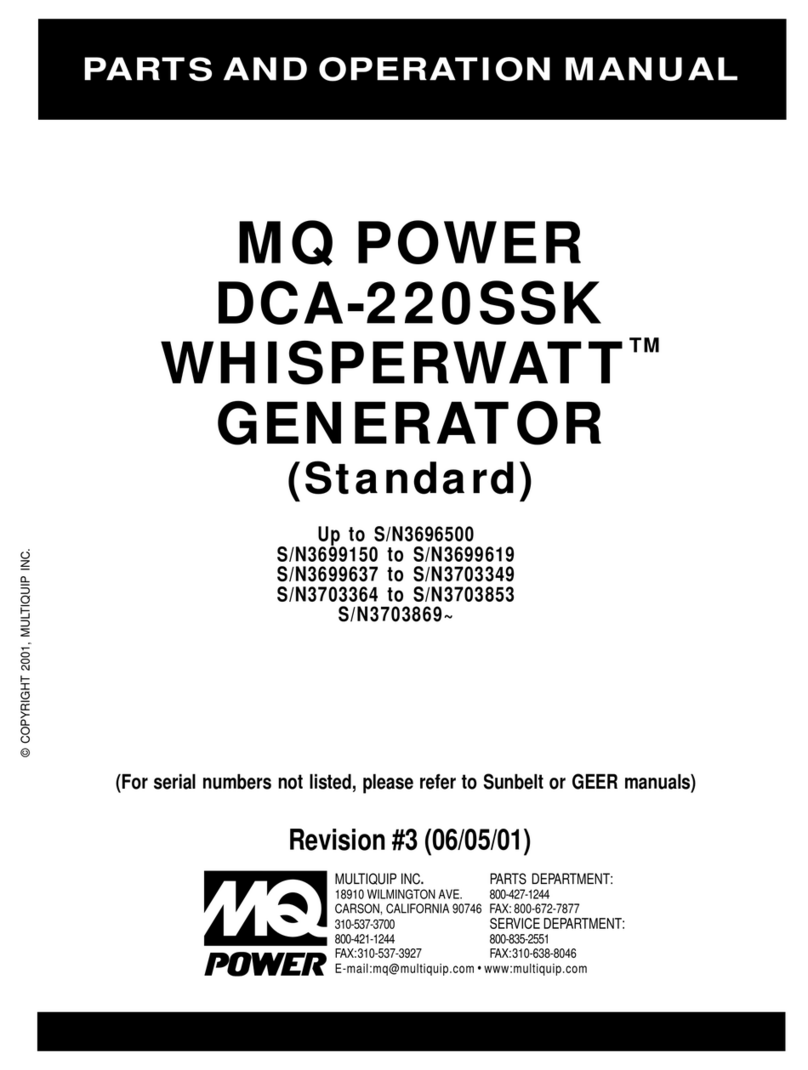
MULTIQUIP
MULTIQUIP Power WHISPERWATT DCA-220SSK Operation and parts manual

Energizer
Energizer HardCase Professional EVEREST 300 user manual

Zipper Mowers
Zipper Mowers ZI-STE2000IV user manual
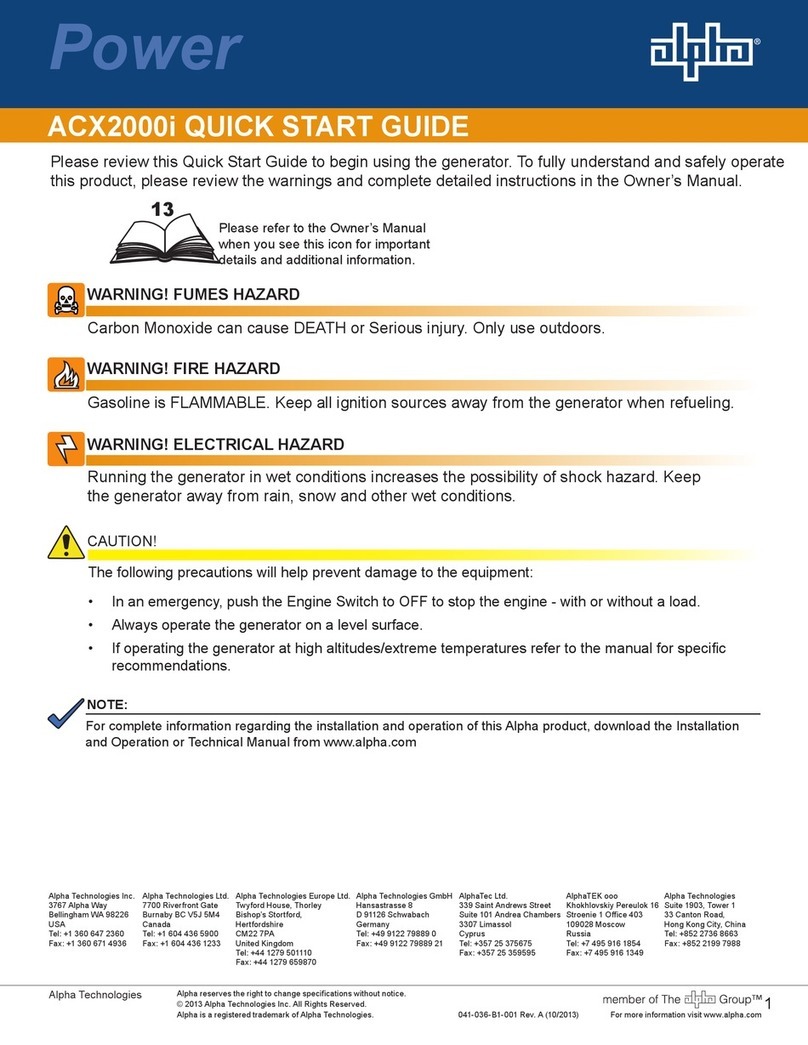
Alpha
Alpha ACX2000i quick start guide
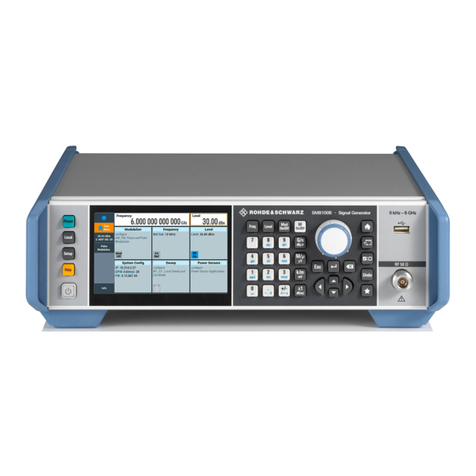
Rohde & Schwarz
Rohde & Schwarz SMB100B Release notes

